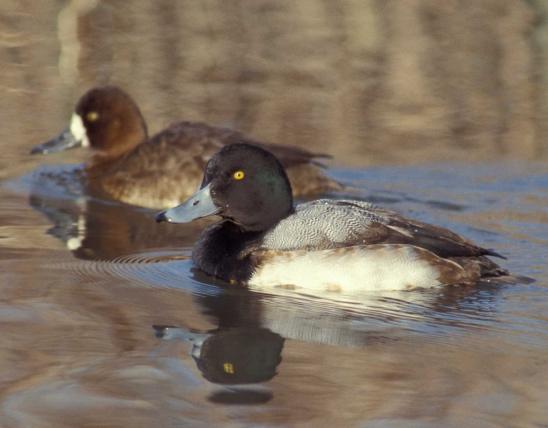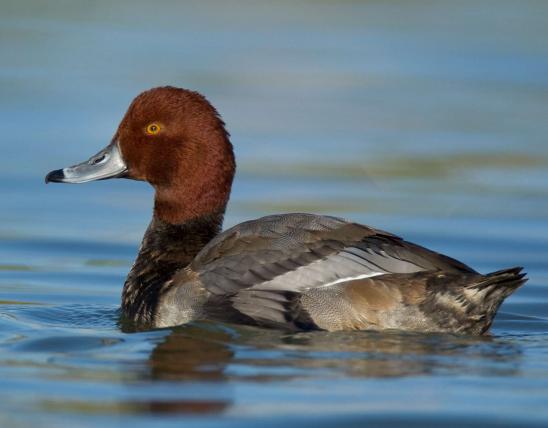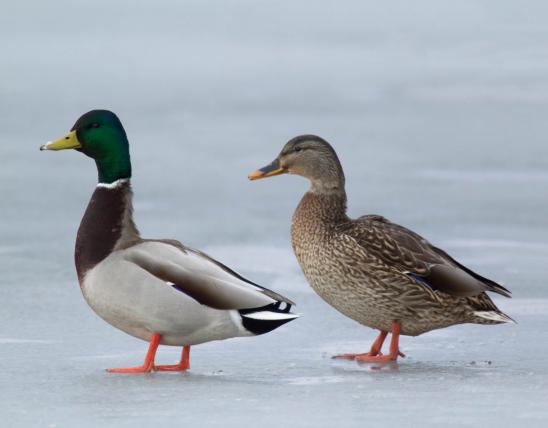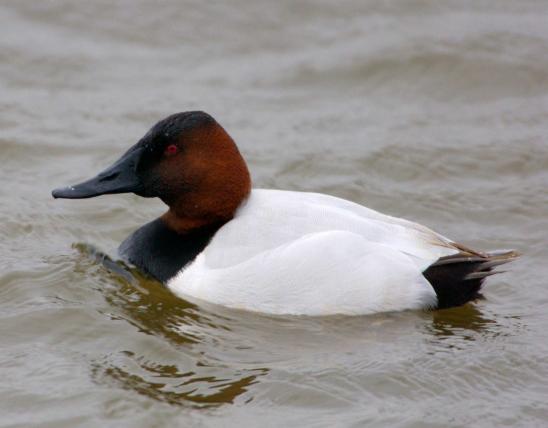
The peaked head and sloping forehead help identify the ring-necked duck. The adult male is all dark, with well-defined gray sides and a white stripe between the sides and the breast. The bill is gray with a white ring and a black tip. The wing stripe is gray. The cinnamon-colored neck ring is usually not visible. The female is dark brown with light brown sides and a white eye ring. The female’s voice is a low-pitched kerrp; the male’s is a thin, low-pitched, nasal whistle.
Like other bay ducks (pochards, or diving ducks), ring-necked ducks dive underwater. Compared to dabblers, they have smaller wings for their weight, so they must work harder to take off from the water surface. To take flight, they run along the surface of the water, patting their feet on the surface. The feet are located farther back on their bodies than on dabblers, making them sit more upright when on land.
Similar species: Lesser and greater scaups have less pointy heads, and the males have gray backs (not black).
Length: 17 inches (tip of bill to tip of tail).

Statewide.
Habitat and Conservation
Occurs in marshes, swamps, sloughs, ponds, lakes, reservoirs, and large rivers, usually diving and foraging in areas free from emergent aquatic vegetation. They seem to prefer shallow, acid marshes. Commonly observed in fall and winter in large “rafts” or groups on open water, often in mixed-species flocks of other bay or diving ducks, including lesser scaup, redheads, and canvasbacks.
Food
Like other diving ducks, ring-necked ducks dive completely underwater to forage, but they can forage by dabbling when necessary. Foods include a great variety of aquatic vegetation and invertebrates.
Status
Common migrant. Rarely seen in northern Missouri in summer, but not known to breed in the state. Common winter resident, especially in southern Missouri. Easily seen at Mingo National Wildlife Refuge or Duck Creek Conservation Area in winter.
Life Cycle
Like many other migratory ducks, ring-necked ducks are most often seen in Missouri as they fly through in spring and fall between their northern breeding grounds and their overwintering territory in western North America.
Human Connections
As with other migratory waterfowl, ring-necked duck numbers are tracked, and game laws are structured to keep populations healthy. People hunt ducks for the challenge, the meat, and simply to be outdoors doing something humans have done for ages.
Ecosystem Connections
Animals that migrate play important ecological roles in both breeding and overwintering territories. They also influence the ecology of every region they travel through in spring and fall.
















Where to See Species
About 350 species of birds are likely to be seen in Missouri, though nearly 400 have been recorded within our borders. Most people know a bird when they see one — it has feathers, wings, and a bill. Birds are warm-blooded, and most species can fly. Many migrate hundreds or thousands of miles. Birds lay hard-shelled eggs (often in a nest), and the parents care for the young. Many communicate with songs and calls.


























